What’s up with free multimedia production tools in 2010
by Alexandre ProkoudineIt's about time to draw a line between 2010 and 2011 and have a look at what was happening to the multimedia production stack of free apps this year.
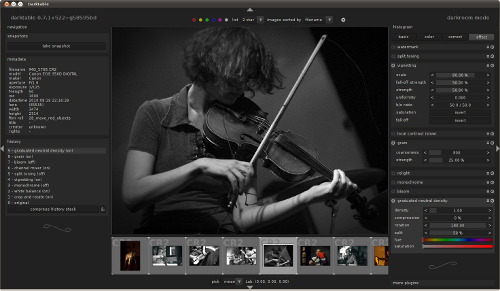
With holiday season right in front of us it’s about time to draw a line between 2010 and 2011 and have a look at what was happening to the multimedia production stack of free apps this year.
We carefully selected most important things that happened or haven’t happened. Read on.
darktable
The v0.4 released in January 2010 was the first version when darktable, a digital photography workflow tool for Linux, became actually usable for daily use. With basic catalog management features, advanced editing tools and, above all, HDR precision darktable is rapidly becoming important part of Linux powered photographers’s workflow.

Since v0.4 the application has become considerably more polished and powerful, and most recent changes in development version (to be released as v0.8) are bringing dramatic performance improvements as well as important new features. More on that in the coming big review.
Hugin
Many important changes have been introduced to this popular free panorama stitching tool this year: HDR deghosting, visualization of connections between images in the project (Layout mode), mosaics mode, linked bracketing etc.
However the most important change this year is a built-in control points detector that is a result of several Google Summer of Code projects in a row. Until just now users had to install a separate package with a control points detector, because the original algorithm was patented in the USA.
Now thanks to a new patent-free control points detector installing and getting Hugin to work is considerably less of a hassle. The release candidate of this version was released yesterday with final version due to be out in a matter of days.
GIMP
For GIMP it’s been a rather difficult year. The upcoming v2.8 has been under development for a little over two years already, and this year just one development version was released. This has a lot to do with two principal developers having very little time for development, but also with considerable lack of new committed contributors.
Nevertheless a lot of work has been done during this year:
- optional single-window mode became available in v2.7.1 (actual work was done in 2009);
- most of GIMP’s rendering, including tools, has been ported to Cairo;
- layers grouping was implemented;
- brush dynamics got major improvements and for the first time ever surpasses Adobe Photoshop in terms of flexibility;
- the text tool finally works right on canvas and has inline formatting controls.
The team is currently working towards fixing various issues and tying up loose ends.
GNOME Color Manager
G-C-M that was first released in late 2009 made its way to mainstream distributions during 2010 after becoming official part of GNOME. This simply means that after all these years color management is now available to everyone on Linux. If it doesn’t make 2010 the year of Linux on desktop, then what does? :)
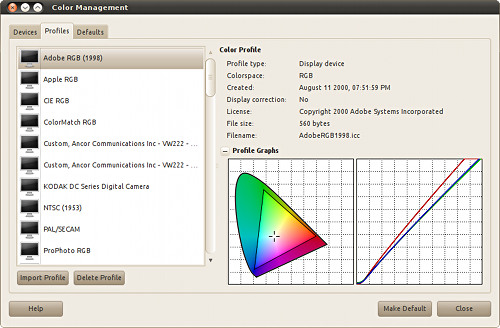
During this year a lot of work has gone into porting GNOME Color Manager to GNOME technologies, however quite important new important features were implemented as well, such as profiling of scanners and printers, user interface improvements and last, but not least, beginnings of DDC/CI support.
Some of the new features originally were supposed to be part of GNOME 2.32, but as you probably remember GTK+3 in GNOME switch was postponed, and thus some of them are going to be available in the next release of GNOME, scheduled for April 2011.
Blender
The first alpha of Blender 2.50 with a major overhaul of user interface as well as animation system and particle system was released in November 2009. During this year 2.5x branch has received so much love that the current version, 2.55 can actually be used in production. You can find an extensive overview of changes here.
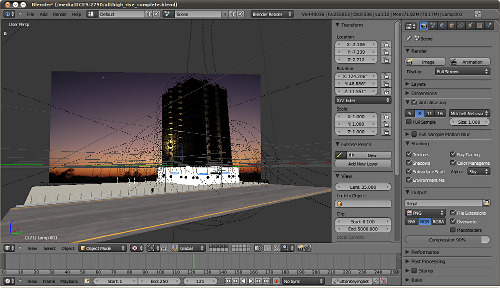
The team now has two part-time programmers (instead of one full-timer) who along with other team members work hard at keeping amount of bugs down. if you are interested how things progress regarding bugfixing, you can follow Ton Roosendaal on Twitter.
The project also had a successful run in Google Summer of Code 2010 program with ten projects, some of them already available for users in generic releases, while others are available as graphicall builds.
And of course it’s quite impossible not to mention Sintel — a new short animation movie by Blender Foundation. Just facts: over 2.000.000 watches on YouTube, premiere on a prestige movie festival in Netherlands, sponsored by community and with direct community participation.
You can also buy DVD with actual project data released under open license, or download just video.
Ramen
Officially announced in late 2009, Ramen, a very promising open source node based compositing tool, was twice left by its only developer this year, the latter time being fatal for the project. There are two major reasons for that.
First, development was out of sync with user base. Most people stick to Windows, and there have been no Windows builds fairly recently, only Mac and Linux 64bit ones were built and uploaded most of the time. No matter how much we love Linux, the majority is still using Windows. It’s a trap so easy to fall in especially when target audience is already small.
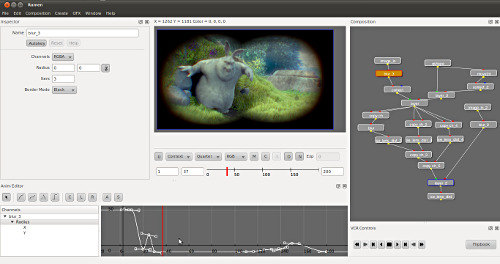
The second reason is that the project failed to attract new developers. Mostly Esteban was on his tod, and that rarely adds up to motivation. To work on a project likes this you need a quite good expertize, and when you have one, it’s not really common to work on a free project.
The project is now “continued” by few dedicated users who try to make some buzz and attract developers.
Kdenlive
I know that many users prefer OpenShot to other free non-linear video editors, but I have lots of reasons to cover Kdenlive instead. One of them is that Kdenlive team actually actively participates in projects like MLT and frei0r. Since summer 2010 or so they contributed quite a lot new frei0r effects which benefits the whole NLE ecosystem, because both OpenShot, PiTiVi and various free VJ tools rely on frei0r.
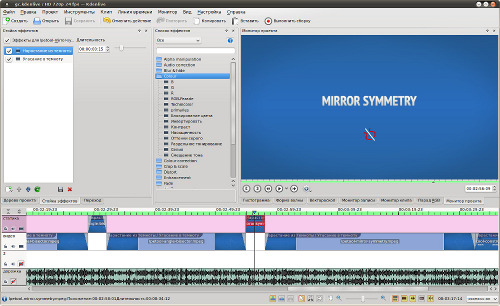
The other reason is because Kdenlive now has traditional color analysis (waveform, RGB parade, histogram and vectoscope), as well as adjustment tools (levels, curves and SOP/Sat) that professional users cannot live without.
Finally, v0.7.8 released this autumn features heaps of bugfixes which made Kdenlive simply usable for many people.
Ardour
I was sort of hoping to see beta of Ardour 3 (a3 for short) to be released this year. Sadly, the project is only getting closer to the first official alpha release. Even so amount of changes that have gone into the 3.0 branch over last few years is truly impressive. You can find an extensive yet not full list of them here.
In short, changes cover both functionality (MIDI tracks with VSTi support, much improved panning), performance (threaded DSP operations that your QuadCore is gonna love) and usability (matrix-based routing etc.):
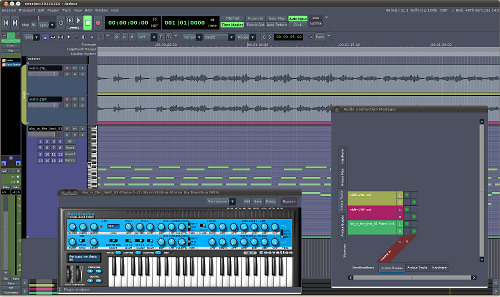
I’ve been testing a3 for last couple of months extensively and all I can say is that you’re going to want babies with Ardour 3. While not being a drop-in replacement for Apple Logic or Cubase in terms of MIDI related features or built-in instruments (Ardour doesn’t ship any), it’s a major step towards usable DAW that doesn’t focus entirely on audio or MIDI — a huge issue we’ve been dealing with on Linux all this time (saving Qtractor’s presence). We owe this to Paul Davis, Carl Hetherington, David Robillard and many other contributors.
You are free to build a3 from SVN as long as you agree to stick to it and rebuild regularly, if you intend to submit bug reports. Providing binary builds to users is strongly not recommended at this point. For production Ardour 2 is still the best and trusted solution.
LADISH
Yet another issue with Linux music production toolbox is about to disappear thanks to this year’s work by Nedko Arnaudov and developers of various JACK clients. If you ever tried doing any music production on Linux you surely know that flexibility of JACK used to be considerably toned down by absence of a working session management solution. Given how many softsynths are implemented as standalone applications and not plug-ins, restoring connections between JACK clients was a hell of job that easily turned down users.
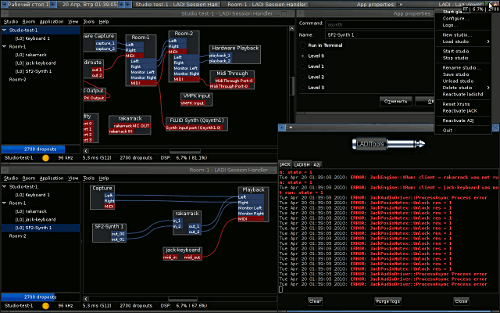
LADISH combats this mess by means of providing tools to save and replay connections between applications, providing several layers of interaction with applications, explained here. What it boils down to is that you can create virtual rooms to connect your hardware and software and then simply use it. Here is a tutorial that explains everything in details.
LADISH is currently supported by Ardour, Rosegarden, Hydrogen, Bristol, Yoshimi, FeSTige, Calf’s JACK host etc.
Effects
Effects are important part of any multimedia production workflow as they leverage work on additional features to 3rd party developers and help keeping core functionality of an application clean and lightweight.
Video effects on Linux are mostly represented by frei0r API that is used by a number of tools such as Kdenlive, OpenShot, PiTiVi, VeeJay, LiVES etc. Until late April this year development of frei0r was stalling, but then it was picked up by Dan Dennedy of MLT and Kdenlive fame who was later joined by other developers who implemented a fair amount of handy effects, some of them being core of new color correction tools in Kdenlive. However all the effects use a 8bpc data format which means that you pass your video stream through a lossy pipeline. At some point it’d be nice to have someone fix this.
Ramen seems to be the only free host of OFX effects. Esteban Tovagliari tested quite a number of popular commercial VFX plug-ins used in production worldwide and even ported two Blender nodes to OFX, however the problem with Ramen is that it is, as you already know, considerably developerless at the moment.
In the world of free audio effect APIs LV2 is currently the most up to date standard that allows creating audio effects and virtual instruments with custom UIs and arbitrary amount of inputs and outputs.
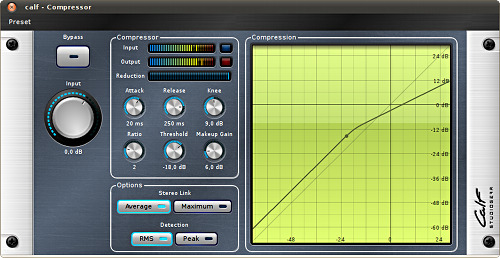
Despite of rapid progress of e.g. Calf plug-in suite (especially this year) and even availability of commercial linux DSP plug-ins created by an ex-SSL developer the situation is not exactly great.
First of all, active development of plug-ins stopped around mid-2000s when LADSPA was still the king (and probably still is). There is probably just a hundred of LV2 plug-ins available now, and mostly they are audio effects. Very few virtual instruments are written at all.
The next problem is that there are not so many LV2 hosts around, and Ardour 3 seems to be the only one that supports persist extension (LV2 has a compact core spec and a number of extensions) which means it’s the only host that can save and restore plug-in’s options (Update: apparently Qtractor does it too, tnanks, Autostatic!).
Finally, nearly half of LV2 effects ever written are not exactly well maintained: e.g. both swh’s port to LV2 and mda’s port to LV2 haven’t been touched for long.
Luckily this year we’ve seen rise and shine of several projects that aim to simplify development of audio effects and virtual instruments. These are:
- NASPRO — a framework for LV2 plug-ins development that contains Permafrost — a DSP programming language with preprocessor into C code and Turtle/RDF metadata.
- Holos — a framework for plug-ins development, currently supporting only VST and LADSPA, but aiming for LV2 too.
- FAUST — another DSP programming language with preprocessor in C++ code, streamlined for physical modeling and already used this year to recreate sound of Yamaha YC-20 (LV2 version of the synth is expected later).
So if you are eager to do some LV2 programming, check them out.
Books and Education
Books and courses on content production software play an essential role in making this software acknowledged and actually used. Much can be said about every book, but a full listing will probably be of more use to you :)
Blender:
- Fundamentals of Paper Model Design by Angel David Guzmán, a free e-book
- Blender 2.49 Scripting by Michel Anders, Packt Publishing
- 3D for iPhone Apps with Blender and SIO2 by Tony Mullen, Sybex
- Blender Studio Projects: Digital Movie-Making by Tony Mullen and Claudio Andaur, Sybex
- Blender 3D 2.49 Architecture, Buildings, and Scenery by Allan Brito, Packt Publishing
- Blender 2.5 Lighting and Rendering by Aaron W. Powell, Packt Publishing
- Beginning Blender: Open Source 3D Modeling, Animation, and Game Design by Lance Flavell, Apress
- Blender - Créez des animations 3D (in French) by Jean-Michel Soler and Marie-France Soler, Eyrolles
- La 3D libre avec Blender (in French) by Olivier Saraja, Eyrolles
- Grafica 3D con Blender (in Italian) by Francesco Siddi, Apogeo
- Blender Foundations. The Essential Guide to Learning Blender 2.6 by Roland Hess, Focal Press
Inkscape:
- Beginning Inkscape by Donna Benjamin, Jon Cruz, Simon Klein and Mark Bystry, Apress
- Inkscape 0.48 Essentials for Web Designers by Bethany Hiitola, Packt Publishing
- Inkscape. Professionelle Vektorgrafiken gestalten (in German) by Uwe Schöler, Addison-Wesley
Processing:
- Getting Started with Processing by Casey Reas and Ben Fry, O’Reilly Media
- Processing for Visual Artists: How to Create Expressive Images and Interactive Art by Andrew S. Glassner, A K Peters
- Processing — eine Einführung in die Programmierung (in German) by Andres Wanner, Hans Peter Wyss, Roland Broennimann and Roman Schnyder, Lulu Press
- Processing (in French) by FLOSS Manual contributors, FLOSS Manuals, Lulu Press
Other books:
- GIMP Bible by Jason van Gumster and Robert Shimonski, Wiley
- OpenSceneGraph 3.0: Beginner’s Guide by Rui Wang and Xuelei Qian, Packt Publishing
- Python 2.6 Graphics Cookbook by Mike Ohlson de Fine, Packt Publishing
- Scribus 1.3.5: Beginner’s Guide by Cedric Gemy, Packt Publishing
- Ardour workflow manual by lots of contributors, FLOSS Manuals
However the most interesting book project this year seems to be “The Wow Factor” e-book by Andrew Price. Not only it was the first book to cover Blender 2.5x series, but it’s also a rather unusual approach to writing books: Andrew provides free updates of the book to all customers till 2012, both fixes and content updates to match changes in software. The book shot in May and after just two weeks in sale it went long beyond coverage of production expenses, so that Andy left his day job to focus on creating training materials to Blender users at his Blender Guru web project.
Another important educational project that is related to Blender is “Chaos and Evolution” DVD by David Revoy, art director of “Sintel” movie (here is our interview with David). This is the first complete video course on digital painting created with GIMP, MyPaint and Al.Chemy in mind. Interestingly enough the course focuses more on workflow and drawing/painting techniques than on particular software features. Later, in October David attended VIEWConference 2010 in Turin, Italy, to do a series of workshops on GIMP and MyPaint and gave a talk about his experience using free painting tools for a real-life project (“Sintel” again).
Blender was also leading in amount of courses of workshops around the globe this year: USA, Germany, Italy, UK, China, Colombia, Mexico… And the list goes on.
Trends and general pitfalls
It’s quite noticeable that free content production tools now follow the worldwide trend to finally make a good use of multicore configurations and GPUs. The major problem on Linux here is lack of free drivers that support 100% of GPUs features, and all kinds of issues with binary drivers (like no XRandR 1.3 support in NVidia).
Many mature production tools are currently undergoing or finishing major refactoring, because having a huge code base is a bad excuse to not keep it manageable and not update it for state of the art technologies. Blender does it, so do GIMP, Inkscape, Scribus, Synfig, Ardour and so on and so forth.
Another interesting trend is return of old project that have been forgotten long ago by some users and never heard of by others: LAoE audio editor, qmidiarp arpeggiator etc.
One common problem many projects share among each other is lack of contributors who do things other than programming and testing: usability engineers, designers etc. It’s quite unfortunate that tools for creating design actually lack proper design themselves. The problem is much larger than that and demands a dedicated publication.
Another thing that we don’t see yet is advanced collaboration between projects. OpenRaster is cool, but being able to work on same project e.g. in both MyPaint and GIMP simultaneously is quite desirable, and Verse isn’t exactly the right answer to that.
Upwards and onwards
So, what is 2011 holding for us? Here is a rough list of things we are likely to see next year:
- Blender 2.60, all the new features you already know plus official “recommended” label, also most likely — long anticipated things like bmesh in official development builds.
- GIMP 2.8. Once it’s out, GEGL is likely to go deeper inside GIMP. Everybody wins.
- darktable 1.0. Nobody knows what exactly 0.8-1.0 will bring, but you can be sure that everything will be processed on GPU via OpenCL.
- Scribus 1.4.0. A long overdue new stable version of this WYSIWYG desktop publishing tool is currently planned for February or so. In best case we’ll also get 1.6.0 with better UI and support for complex scripts.
- Inkscape 0.49. Full Cairo based rendering with parallelized SVG filters rendering, D-Bus based scripting.
- Ardour 3. Well, hopefully. And once a3 is out of the door, video tracks already implemented by Robin Gareus will be merged.
- MusE 2. Alpha version of this MIDI sequencer has just been released, and there’s a new team working on the project quite actively.
- MuseScore 1.0. This score editor made a huge leap this year, both feature-wise and popularity-wise. We can only expect more next year.
- Lightworks. Linux and Mac versions of this award-winning (sorry for the buzzword) non-linear video editor is planned for late 2011 with source code — open and free.
- Libre Graphics Meeting 2011. This year’s instance of the conference was a tremendous success. We cannot dare to make LGM2011 only as good as the 2010 one.
And who knows, maybe you have something to surprise everybody with. In that very case we’ll be watching you :)
Patreon subscribers get early access to my posts. If you are feeling generous, you can also make a one-time donation on BuyMeACoffee.
